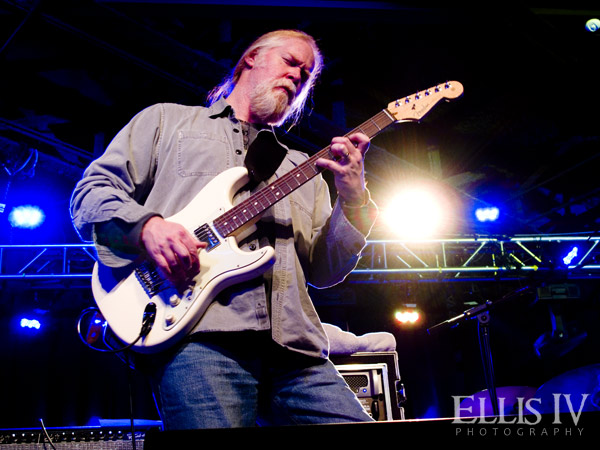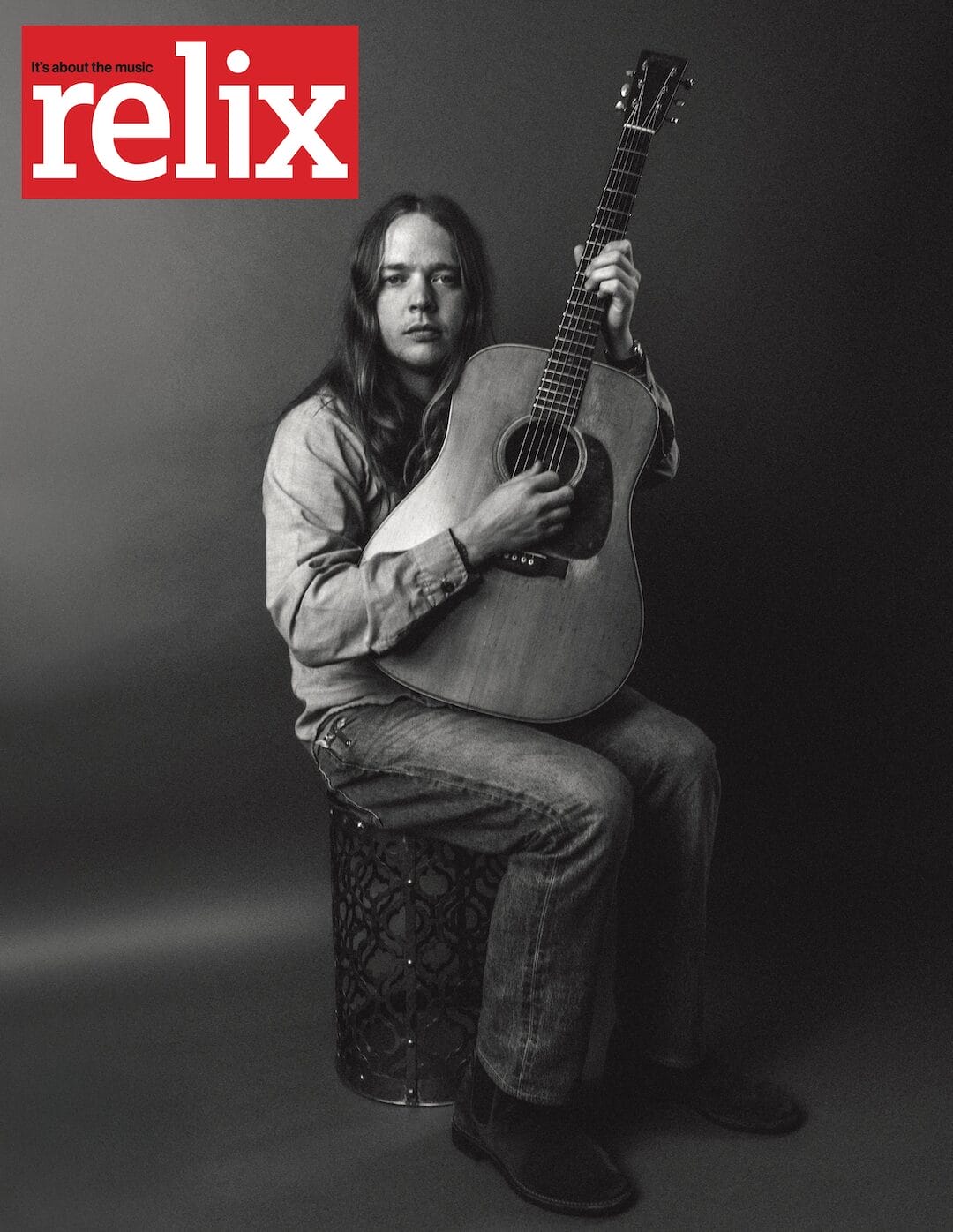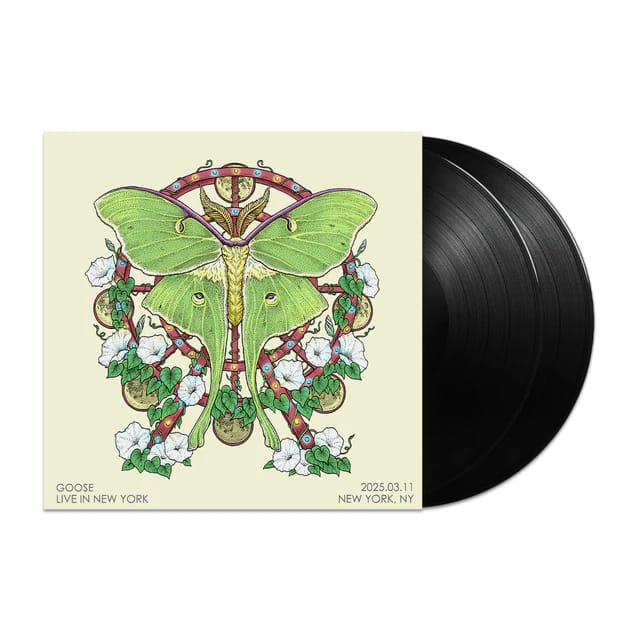Jimmy Herring Crafts His Own _Lifeboat_ (Relix Revisited)
Jimmy Herring is now out on tour with Widespread Panic, so we thought it a fine time to revisit this feature on the guitarist, which ran in the December/January 2009 issue of Relix_.

_Photo by Ellis Jones
Any number of fleet-fingered lead guitarists who have steadily dazzled arena audiences would take umbrage at being described as a sideman. Jimmy Herring isn’t one of them.
“People have asked me why I haven’t put out my own album before now but I was always more interested in being a sideman. Instead of being a band leader, I decided that I would be the best sideman that I could be.”
As he spends a quiet afternoon in his Georgia home, days before heading out on a fall tour with Widespread Panic, Herring takes some time to look back on the paradox of his teenage years (more on that momentarily), en route to a discussion of Lifeboat, the solo album first envisioned as a group project that serves as the culmination of a series of fortunate events than began three days after he returned to the South in 1986, following a Hollywood interlude.
Herring’s distaste for the band leader role stretches back to the group he assembled as a teenager. He began playing guitar in 1975 at age 13, drawn to Led Zeppelin, Hendrix and “even Kiss and Aerosmith.” However, as he aspired to assemble his first band, he hit a wall, as he soon discovered that “finding a singer was impossible. Nobody could sing Aerosmith, nobody could sing Led Zeppelin in my little hometown of Fayetteville, North Carolina.”
One of his two older brothers then offered a rather striking alternative. “He said, ‘I can see you’re frustrated, why don’t you just get into some instrumental music?’ I said, ‘Like what?’ So he played me Innermounting Flame. And I was like ‘Ohhh… ’”
Ohhh indeed.
Innermounting Flame, the momentous debut release from John McLaughlin and Mahavishnu Orchestra offered a complex, rousing amalgam of jazz and rock that, as befits Herring’s Lifeboat, often is described as the high-water mark of fusion.
“For the first time, I heard something that was completely, utterly, totally out of reach. I probably listened to that music for two years before I ever attempted to play any of it and the easier parts of it started to seep into my subconscious. Then I started getting braver, learned some of the more difficult passages and sooner or later some of them started to materialize.”
Emboldened, Herring formed Paradox, an ambitious group that also delved into the music of The Dixie Dregs and Tony Williams’ Lifetime (which initially featured McLaughlin and later another guitarist significant to Herring’s development, Allan Holdsworth). Unable to secure a willing keyboard player, Herring arranged these parts for a three-piece horn section.
Ultimately though, it was a case of too much too fast. “I guess I was a little too serious too young. We were getting into some real heady music and I might have been too heavy about things that were not that important. The worst part, is some of my friends started calling me a slave driver. So that’s when it came into my mind, if I just worked on my own stuff, it would be hard enough.”
Paradox dissolved and Herring relocated to Hollywood to begin a course of study at the Guitar Institute of Technology. His parents, a superior court judge and a high school English teacher, had long encouraged him to pursue a more formal musical education but initially he had rebuffed them, because, as he now laughs, “I told them, ‘I play rock and roll, I’m from the street.’” At GIT, where he befriended fellow student Jeff Buckley, he refined his technique and received another education as well, bristling at the pay-to-play mentality of the L.A. club scene, which required bands to purchase sold-out gigs a few months in advance. So in 1986, Herring returned to his native South, taking up an offer from one of his teachers to become an instructor at the fledgling Atlanta Institute of Music.
Less than 72 hours after he arrived in Atlanta, his future course was set.

An early Aquarium Rescue Unit press photo
Guitarist Scott Henderson came to town for a free clinic in support of the school. There, Henderson was teamed up with local musicians, including a drummer named Jeff Sipe, whose performance exhilarated Herring.
“I was completely overtaken and I went up to him and said, ‘I just moved to town three days ago and it looks like I came to the right place. Are all the drummers here like you?’”
He now chuckles at his naiveté.
“Of course all the drummers weren’t like him, there is only one Jeff Sipe. Then I said, ‘I’d really like to get together with you some time if possible.’ Now he didn’t know anything about me but he was super cool and said, ‘Well, what are you doing tomorrow?’ So I went over to his house and we played for four hours. I felt like I had found a musical soul mate on my third day in town. Then a week later he calls me up, ‘Dude, these two guys from Virginia Beach just moved into my house, they’re brothers and they are unbelievable, you’ve got to get over here right now,’ And it was Kofi and Oteil [Burbridge]. So I went over there and I was just flabbergasted at their incredible musicianship.”
While Herring began his teaching gig, Sipe and the Burbridge brothers supported themselves by playing in Top 40 cover bands ( “That was the way to make a living back then. All these incredible musicians were playing Top 40.” ). The four also began shedding together in their off hours with the intent of developing a body of original material.
But then the Colonel came calling.
Herring remembers, “After a short while Sipe started playing with [Col.] Bruce Hampton and came back to us saying, ‘I’m playing with this dude and it’s so weird, it’s so liberating. You can play anything you want and nobody tells you what to wear, nobody tells you how to play, it’s the craziest thing. Eventually Oteil started playing with Bruce and they lost interest in what we were doing.”
A number of months later Herring was invited to attend a gig ( “They thought I really wouldn’t be into it because it was so crazy and so much like performance art but I was thoroughly entertained.” ). Then Hampton extended an offer for the guitarist to return another night and sit-in with the band ( “He made me sit through two sets and I was about to explode” ). The following day, Hampton invited Herring to join The Aquarium Rescue Unit.
“I learned so much but the biggest thing I learned was to unlearn things. Before I started playing with Bruce, technique was a big focus of what I was doing. All my favorite musicians had tons and tons of technique but he shot all that down. ‘What is that scholastic crap you’re playing?’ Or he’d say, ‘Play that sunset over there. Come on, you’re some bitchin’ guitar player, play the sunset.’ So I tried and he’d go, ‘No, no, no.’ Then he’d grab the guitar and play the sunset. He worked really hard on showing us how to get out of our own way.”
This approach continued to inform Herring’s music even as Hampton and Sipe departed the group in 1994, due to health reasons and a (Leftover) Salmon run. ARU became increasingly inert ( “Although we never broke up” ) and Herring soon brought his egoless approach, a predilection for practice and his own grounded, humble nature to a series of increasingly high-profile endeavors.
In 1998 he was invited to join Mahavishnu drummer Billy Cobham, Weather Report bassist Alphonso Johnson and Dixie Dregs keyboardist T Lavitz in Jazz Is Dead, a project that enabled him to perform with three of his childhood heroes ( “It was scary but they made it so easy. And eventually Billy ended up leaving and we got Rod Morgenstein [Dixie Dregs]. That was awesome, too, I felt, ‘God has blessed me, it’s raining great drummers!” ). The summer of 2000 saw him reunited with Oteil Burbridge while sharing guitar duties with Derek Trucks in The Allman Brothers Band ( “I really started playing because of that music and I got to play with Derek and Oteil, so it was awesome. But Dickey hadn’t died, so I felt I couldn’t stay.” ) From there he began an extended stint with Phil Lesh & Friends, which led to his role in the reconstituted Grateful Dead.

Photo by Ellis Jones
Herring acknowledges that along the way some of his acquaintances questioned these pursuits.
“I’ve had this conversation with people in the jazz world who thought it was a sell-out thing if you played with people who play in front of huge crowds and generate a lot of income. I don’t feel I have to defend myself but I would try to explain, ‘Look, this is part of who I am, too.’ I like to play loud and I like to play distorted and I like to bend notes and vibrato like Angus Young. You always have to be in touch with your roots. So when I’m called to play with The Allman Brothers, they’re totally my roots. Then with the Dead, that was a challenge and I’m always up for a challenge. I couldn’t copy Jerry because that wouldn’t be right, but yet I couldn’t play the way I normally play. And for anyone who thinks that was an easy gig, I challenge them to learn 280 songs.”
Then in 2006 he received an offer that he had declined four years earlier. Michael Houser originally had envisioned Herring as his successor in Widespread Panic but Herring had declined due to his prior commitments. When John Bell called him with a similar offer in 2006, he opted to give it a go and the impact would lead Herring to his Lifeboat.
“Being around them and learning their catalog and just talking to JB, his philosophy is very similar to a jazz musician. He never really does it the same way twice. If you listen to him play, he’s totally improvising almost all the time and when he sings he’s totally improvising all the time. I was so inspired. We were playing gigs and when we’d get to the hotel room I would play another three hours some nights. And I started studying some and that’s when the nucleus for these tunes started popping up.”
However energized he was about the new material, Herring retained his initial reluctance to serve as a band leader. Instead, he envisioned a group project with Derek Trucks, Jeff Sipe and the Burbridges. Trucks’ label commitments and the fact Herring already had songs good to go, ultimately led his friends and colleague to nudge him toward his solo debut recording. However, in many respects, he sees this as a Jimmy Herring project in name alone.
“To me it was all about making a record of music and not guitar music. Some people might be disappointed because they thought it would be a guitar shred festival the whole time but I didn’t want to do that. The idea was to have the music be the main thing, not the guitar. That’s why the flute and the horn and the different musicians are featured as much as I am.”
Lifeboat offers ten instrumentals delivered by a core band of Herring, Sipe and Oteil, with Kofi appearing on most tracks and Trucks on a pair as well. The focus is on the compositions, which are the product of an avowed “rock and roll musician who loves jazz.” One senses Herring’s deep admiration of Mahavishnu, the Dregs, Allan Holdsworth and Wayne Shorter. Yet while there is a complexity to the compositions, they rarely come across as flashy. Herring explains, “Being around all these songwriters for the last eight years, hanging around Bob Weir, Warren [Haynes], Bobby Lee Rodgers, JB and the boys from Panic, kind of rubbed off on me a little bit, even if these songs are very different. What I was hoping to achieve with this record was to have a spiritual connection but in the context of the songs.”
One can also call Lifeboat progressive music in the sense that it builds on the spiral of Herring’s career, while remaining true to his core passions that have long animated him. To underscore this point is a version of the “Jungle Book Overture,” a song that first captivated Herring as a five-year-old, long before he picked up a guitar. So too, the performances carry a certain fitting resonance, as Herring affirms, “It reminds me of 1986 all over again when Sipe called me and said ‘These brothers just moved into my house from Virginia Beach and they’re killing it.’”




















